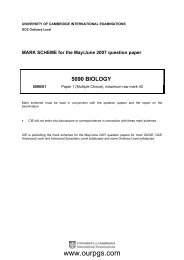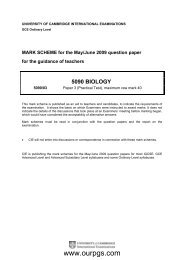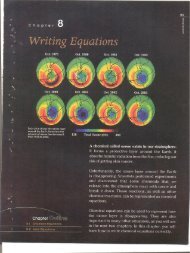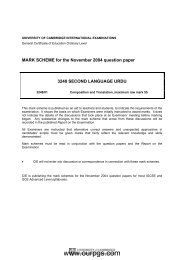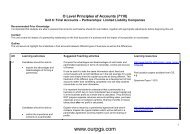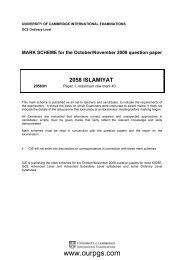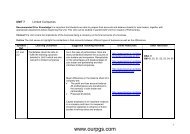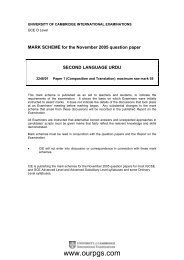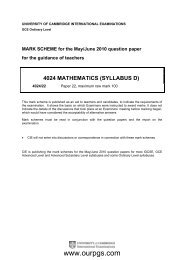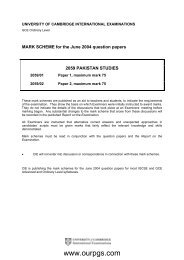Additional Combined Science-P2-O.N-02.pdf - ourpgs.com
Additional Combined Science-P2-O.N-02.pdf - ourpgs.com
Additional Combined Science-P2-O.N-02.pdf - ourpgs.com
You also want an ePaper? Increase the reach of your titles
YUMPU automatically turns print PDFs into web optimized ePapers that Google loves.
Centre NumberCandidateNumberCandidate NameCAMBRIDGE INTERNATIONAL EXAMINATIONSJoint Examination for the School Certificateand General Certificate of Education Ordinary LevelADDITIONAL COMBINED SCIENCE 5130/2PAPER 2OCTOBER/NOVEMBER SESSION 20022 hours 15 minutes<strong>Additional</strong> materials:Answer paperTIME2 hours 15 minutesINSTRUCTIONS TO CANDIDATESWrite your name, Centre number and candidate number in the spaces at the top of this page and onall separate answer paper used.Section AAnswer all questions.Write your answers in the spaces provided on the question paper.Section BAnswer one part of each of the three questions.Write your answers on the separate answer paper provided.At the end of the examination, fasten all separate answer paper securely to the question paper.INFORMATION FOR CANDIDATESThe number of marks is given in brackets [ ] at the end of each question or part question.A copy of the Periodic Table is printed on page 16.FOR EXAMINER’S USESection A101112TOTALMML 1461 4/01 S20100This question paper consists of 16 printed pages.© CIE 2002 UNIVERSITY of CAMBRIDGE[Turn overLocal Examinations Syndicatewww.<strong>ourpgs</strong>.<strong>com</strong>
2Section AForExaminer'sUseAnswer all the questions.1 The parts of the electromagnetic spectrum are listed below in alphabetical order.gamma rays infrared microwaves radio wavesultraviolet visible light X-rays(a)In the table in Fig. 1.1, list the parts of the electromagnetic spectrum in order ofwavelength, starting with the shortest wavelength.shortest wavelengthlongest wavelengthFig. 1.1 [4](b)Long exposure of the skin to ultraviolet light causes sunburn.Long exposure to visible light causes no harm to the skin.Explain this difference......................................................................................................................................................................................................................................................................................................................................................................................................................... [2]5130/2/O/N/02www.<strong>ourpgs</strong>.<strong>com</strong>
(c)3Radiation is given out when isotopes such as cobalt-60 decay.(i) What is meant by the term isotopes?................................................................................................................................................................................................................................................................................................................................................................................................ [2]ForExaminer'sUse(ii)Gamma rays emitted by cobalt-60 are used to treat cancer.State one safety precaution needed when this treatment is used............................................................................................................................. [1]5130/2/O/N/02www.<strong>ourpgs</strong>.<strong>com</strong>[Turn over
2 The apparatus shown in Fig. 2.1 is used to obtain ethanol from fermented liquor.4ForExaminer'sUseheatFig. 2.1(a) Choose from the list below to label the apparatus in Fig. 2.1.condenser ethanol fermented liquor filter funnel stirring rod thermometer[4](b)The fermented liquor is made from a solution of sugar in water.Explain how the sugar solution is fermented......................................................................................................................................................................................................................................................................................................................................................................................................................... [2]5130/2/O/N/02www.<strong>ourpgs</strong>.<strong>com</strong>
3 The diagram in Fig. 3.1 shows parts of the human digestive system.5ForExaminer'sUseABCDFig. 3.1(a) Label the parts A, B, C and D on the diagram. [4](b)Complete the table in Fig. 3.2 showing the function of some parts of the humandigestive system. [3]part of the digestive systemfunctiongall bladderpancreasrectumFig. 3.2(c) (i) What is the function of peristalsis?............................................................................................................................ [1](ii)How is peristalsis carried out?................................................................................................................................................................................................................................................................................................................................................................................................ [2]5130/2/O/N/02www.<strong>ourpgs</strong>.<strong>com</strong>[Turn over
4 The diagram in Fig. 4.1 shows a simple electric bell.6ForExaminer'sUsehammergongcellcoiliron barfixedcontactspringymetalironcoreswitchFig. 4.1The bell uses electromagnetism to make it work.(a) (i) When the switch is closed, the hammer hits the gong.Explain why................................................................................................................................................................................................................................................................................................................................................................................................. [2](ii)The hammer then moves back to its original position.Explain why................................................................................................................................................................................................................................................................................................................................................................................................. [2]5130/2/O/N/02www.<strong>ourpgs</strong>.<strong>com</strong>
(b)(c)7Why is a permanent magnet of no use in this bell?........................................................................................................................................................................................................................................................................................................................................................................................................................ [2]The electric bell rings louder if the hammer hits the gong harder.In what ways can this electric bell be modified to make it ring louder?.................................................................................................................................................................................................................................................................................................................................................................................................................................................................................................................................................................. [3]ForExaminer'sUse5130/2/O/N/02www.<strong>ourpgs</strong>.<strong>com</strong>[Turn over
5 In an experiment a spatula full of a metal powder is added to an aqueous solution of ametal salt. Any change to the appearance of the solid is noted. The experiment is repeatedwith different metals and metal salts.8ForExaminer'sUseResults for these experiments are shown in the table in Fig. 5.1.solution of metal saltmetalcopper(II) sulphate iron(II) sulphate magnesium sulphatecopper no change no change no changeironlight grey solid turnsto red-brown solidno changeno changemagnesiumlight grey solid turnsto red-brown solidlight grey solid turnsto dark grey solidno changeFig. 5.1(a)(i) Name the red-brown solid formed when iron is added to aqueous copper(II)sulphate solution............................................................................................................................. [1](ii) Explain why this solid is formed................................................................................................................................................................................................................................................................................................................................................................................................. [2](iii) Write an equation for the reaction taking place when this solid is formed............................................................................................................................. [2](b)Aqueous copper(II) sulphate solution is blue.(i)Describe the change to the colour of this solution when magnesium powder isadded............................................................................................................................. [1](ii)Explain your answer to (i)................................................................................................................................................................................................................................................................................................................................................................................................. [2](c)Use the information in the table to place the three metals, copper, iron andmagnesium, in order of reactivity. Begin with the most reactive..................................................................................................................................... [2]5130/2/O/N/02www.<strong>ourpgs</strong>.<strong>com</strong>
6 A survey was made to investigate some effects of smoking on health.9ForExaminer'sUseResults of this survey are shown in the bar chart in Fig. 6.1.250annual deathsper 100 000population20015010050deathsresultingfromlung cancerbronchitis00 1–14 15–24 25+cigarettes per dayFig. 6.1(a)(i) What is the effect of increasing the number of cigarettes smoked per day on thechance of a person dying from bronchitis?.............................................................................................................................................................................................................................................................. [1](ii) What is the effect of increasing the number of cigarettes smoked per day on thechance of a person dying from lung cancer?.............................................................................................................................................................................................................................................................. [1](iii) How do the effects you have noted in (a)(i) and (a)(ii) differ?.............................................................................................................................................................................................................................................................. [2](b)Smokers are also more likely to suffer from emphysema than non-smokers.Emphysema decreases the number of alveoli functioning in the lungs.(i)What is the function of alveoli?................................................................................................................................................................................................................................................................................................................................................................................................ [2](ii)How would a person suffering from emphysema be affected by having fewerfunctioning alveoli in the lungs?............................................................................................................................ [1]5130/2/O/N/02www.<strong>ourpgs</strong>.<strong>com</strong>[Turn over
7 The diagram in Fig. 7.1 shows a crane working on a building site.10ForExaminer'sUseconcreteblockforcejibloadFig. 7.1(a) (i) What is the effect of removing the concrete block from the crane?............................................................................................................................ [1](ii)Explain how the concrete block prevents this effect................................................................................................................................................................................................................................................................................................................................................................................................. [2](b) The crane lifts a piece of steel of mass 800 kg from the ground to a height of 30 m.Calculate the work done by the crane.work = ......................... ........... [3]5130/2/O/N/02www.<strong>ourpgs</strong>.<strong>com</strong>
8 Magnesium burns in chlorine gas to produce the ionic solid magnesium chloride.11ForExaminer'sUseThe table in Fig. 8.1 gives information about the atoms and ions of magnesium and chlorine.formulanumber ofelectronsarrangement ofelectronsmagnesium atom Mg 12 2,8,2chlorine atom Cl 17 2,8,7magnesium ion Mg 2+ 10chloride ion Cl – 18Fig. 8.1(a) Fill in the two gaps in the table. [2](b)Hydrogen also reacts with chlorine forming hydrogen chloride. The <strong>com</strong>poundhydrogen chloride is a gas.(i) What sort of bonding is present in hydrogen chloride?............................................................................................................................ [1](ii) In terms of electrons, how is the bonding in hydrogen chloride different from thatin magnesium chloride?................................................................................................................................................................................................................................................................................................................................................................................................ [2](iii) Magnesium chloride is a solid. Hydrogen chloride is a gas.Explain this difference in terms of the forces holding particles together................................................................................................................................................................................................................................................................................................................................................................................................................................................................................................................................... [2]5130/2/O/N/02www.<strong>ourpgs</strong>.<strong>com</strong>[Turn over
9 The graph in Fig. 9.1 shows how the rate of photosynthesis in a green plant changes withlight intensity at two different concentrations of carbon dioxide.12ForExaminer'sUserate ofphotosynthesisBCDE0.5% carbon dioxide0.05% carbon dioxideAlight intensityFig. 9.1(a)Describe the effect of light intensity on the rate of photosynthesis in the parts of thegraph indicated below.(i) part A............................................................................................................................ [1](ii) part B............................................................................................................................ [1](iii) part C............................................................................................................................ [1](b)Why does the graph ACE show a lower maximum rate of photosynthesis than thegraph ABD?........................................................................................................................................................................................................................................................................................................................................................................................................................ [3]5130/2/O/N/02www.<strong>ourpgs</strong>.<strong>com</strong>
13Section BAnswer one part, either (a) or (b), of each question in this section.10 Either (a) (i) A television set operates at a voltage of 240 V and uses a current of 5 A.The television is switched on to watch a programme lasting 50 minutes.Calculate the number of coulombs of charge flowing through the television setand the number of joules of electrical energy used, during this programme.Show the formulae you are using for your calculations. [6](ii)The television set has a plastic case. Its mains cable has an earth wire and aplug fitted with a fuse.Explain how each of the items printed in italics helps to make the television setsafer to use. [4]Or (b) (i) Draw a diagram showing a ray of light entering a rectangular glass block to helpyou explain the term refractive index.Describe an experiment that you could carry out to find the refractive index ofthe glass. [6](ii)Explain, with the help of a diagram, how refraction makes a swimming poolappear less deep than it really is. [4]5130/2/O/N/02www.<strong>ourpgs</strong>.<strong>com</strong>[Turn over
1411 Either (a) An experiment was carried out to investigate the rate of reaction between calciumcarbonate and hydrochloric acid contained in a flask. The flask was weighed everytwo minutes until all of the calcium carbonate had reacted. Results of thisexperiment are shown in the table in Fig. 11.1.time in minutes024681012mass of flask and contents in grams159.8157.8156.7156.1155.9155.8155.8Fig. 11.1(i)(ii)Use graph paper to plot the results of this experiment.Plot time on the horizontal axis and mass on the vertical axis.Draw a curve through the points. Label this curve X.Describe and explain the change in the rate of reaction during this experiment.[6]On the same axes sketch the graph you would expect if the experiment isrepeated using hydrochloric acid of twice the concentration.Label this curve Y. Explain the shape of curve Y. [4]Or (b) The table in Fig. 11.2 shows properties of four elements from Group VII of thePeriodic Table (the halogens) listed in order of relative atomic mass.halogenrelativeatomic masscolourat r.t.p.melting pointin °Cboiling pointin °Cfluorine 19 yellow –220 –188chlorine 35.5 green –101 –35bromine 80 red/brown –7 58iodine 127 dark grey 114 183Fig. 11.2(i)(ii)Describe trends in colour and state of the halogens at room temperature.The next member of Group VII is called astatine.Predict, with reasons for your choices, the colour of astatine and its state atroom temperature. [4]Describe how one halogen element may displace another from a solution of itsions.Write an equation for a reaction of this type.Use examples of these reactions to show how the reactivity of the halogenelements changes as the Group is descended. [6]5130/2/O/N/02www.<strong>ourpgs</strong>.<strong>com</strong>
1512 Either (a) (i) Describe and explain the differences between a typical cell from an animal andone from a plant. You may use diagrams to help your answer. [3](ii)Describe how root hair cells, xylem vessels and red blood cells differ fromtypical plant and animal cells.Explain how these differences help the modified cells to carry out theirfunctions. [7]Or (b) The diagram in Fig. 12.1 shows a food web in a field of maize.birdbeetlespidercaterpillargreenflygrasshoppermaize plantFig. 12.1(i)(ii)Draw one food chain from this food web.Describe and explain the energy losses from your food chain. [6]The field is sprayed with an insecticide that kills the grasshoppers and greenflies.Describe and explain the effects that this has on the food web. [4]5130/2/O/N/02www.<strong>ourpgs</strong>.<strong>com</strong>
16IDATA SHEETThe Periodic Table of the ElementsGroupII III IV V VI VII 01HHydrogen4HeHelium127LiLithium9BeBeryllium11BBoron12CCarbon14NNitrogen16OOxygen19FFluorine20NeNeon34567891023NaSodium24MgMagnesium27AlAluminium28SiSilicon31PPhosphorus32SSulphur35.5ClChlorine40ArArgon111213141516171839KPotassium40CaCalcium45ScScandium48TiTitanium51VVanadium52CrChromium55MnManganese56FeIron59CoCobalt59NiNickel64CuCopper65ZnZinc70GaGallium73GeGermanium75AsArsenic79SeSelenium80BrBromine84KrKrypton19202122232425262728293031323334353685RbRubidium88SrStrontium89YYttrium91ZrZirconium93NbNiobium96MoMolybdenumTcTechnetium101RuRuthenium103RhRhodium106PdPalladium108AgSilver112CdCadmium115InIndium119SnTin122SbAntimony128TeTellurium127IIodine131XeXenon373839404142434445464748495051525354133CsCaesium137BaBarium139LaLanthanum178HfHafnium181TaTantalum184WTungsten186ReRhenium190OsOsmium192IrIridium195PtPlatinum197AuGold201HgMercury204TlThallium207PbLead209BiBismuthPoPoloniumAtAstatineRnRadon555657 * 727374757677787980818283848586FrFrancium226RaRadium227AcActinium878889 †*58-71 Lanthanoid series†90-103 Actinoid series58140CeCerium141PrPraseodymium5960144NdNeodymium61PmPromethium62150SmSamarium63152EuEuropium64157GdGadolinium65159TbTerbium66162DyDysprosium67165HoHolmium68167ErErbium69169TmThulium70173YbYtterbium71175LuLutetiumKeybaXa = relative atomic massX = atomic symbolb = proton (atomic) number90232ThThorium91PaProtactinium92238UUranium93NpNeptunium94PuPlutonium95AmAmericium96CmCurium97BkBerkelium98CfCalifornium99EsEinsteinium100FmFermiumMdMendelevium101102NoNobelium103LrLawrenciumThe volume of one mole of any gas is 24 dm 3 at room temperature and pressure (r.t.p.).5130/2/O/N/02www.<strong>ourpgs</strong>.<strong>com</strong>



